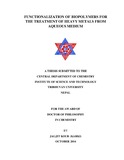Please use this identifier to cite or link to this item:
http://archive.nnl.gov.np:8080/handle/123456789/367| Title: | FUNCTIONALIZATION OF BIOPOLYMERS FOR THE TREATMENT OF HEAVY METALS FROM AQUEOUS MEDIUM |
| Authors: | Kour (Karki), Jagjit |
| Keywords: | Desmostachya bipinnata, Biosorption, Heavy metals, Batch experiment, Pseudo- second order kinetic model, Functionalization, Low cost, Pollution, Biosorbent |
| Issue Date: | 25-Mar-2019 |
| Abstract: | The industrial discharge of heavy metals into waters' course is one of the major pollution problems affecting water quality and human health. Therefore, they must be removed prior to their discharge into waste streams. For this novel cause several types of treatment methods are in use. Among them use of biowaste is emerging as the best method. Therefore different types of agricultural by-products have been explored for their efficiency in removing heavy metal ions from aqueous solution. In this regard a biomass of Desmostachya bipinnata (DB) was investigated as the potential bio-adsorbent for the removal of Cd(II), Pb(II), Cu(II) and Zn(II) from wastewater. DB is a sacrificial herb in the south Asian region particular to Hindu religion with medicinal value. It is found to be very effective in the phyto-accumulation of heavy metals from soil as well as from polluted water. This is the first adsorption studies ever performed with DB as the novel bio-sorbent in the removal of heavy metal ions. Nitrogen functional groups were grafted onto the polymeric backbone of DB with hydrazine monohydrate, dimethylamine and ethylenediamine respectively, for the better adsorption. The characterization of biopolymer was done using SEM, DRFTIR, elemental analysis, zeta potential, XRD and TG/DTA. The characterization results of biopolymer revealed to indicate proper functionalization with nitrogen groups. The effect of pH, initial concentration and contact time of the metal solution were monitored by batch method. The maximum adsorption capacities determined for Cd(II), Pb(II) Cu(II) and Zn(II) were 76.8 mg/g, 130.4 mg/g, 72.1 mg/g and 58.16 mg/g, respectively, at their optimum pH. The equilibrium data were analyzed using Langmuir and Freundlich isotherm models. Langmuir isotherm model fitted well and the rate of adsorption followed the pseudo second order kinetic. The experiments on regeneration and reuse of biopolymers were conducted with batch method. The results indicated that more than 90% of heavy viii metals were regenerated and the biopolymers were used for six successive cycles with 90% efficiency. Thus, the adsorbents derived from DB can be used as an effective, efficient, low cost and environment friendly material for the removal of Cd(II), Pb(II), Cu(II) and Zn(II) from the aqueous medium. |
| URI: | http://103.69.125.248:8080/xmlui/handle/123456789/367 |
| Appears in Collections: | 500 Natural sciences and mathematics |
Files in This Item:
| File | Description | Size | Format | |
|---|---|---|---|---|
| PhD Thesis_JK Final June2015 corrected.pdf | 3.83 MB | Adobe PDF |  View/Open |
Items in DSpace are protected by copyright, with all rights reserved, unless otherwise indicated.